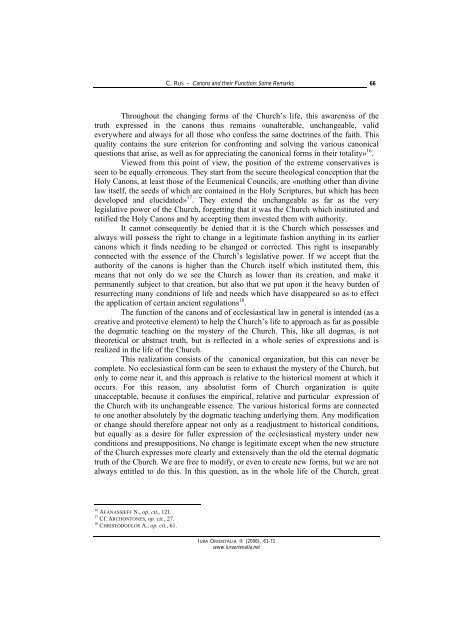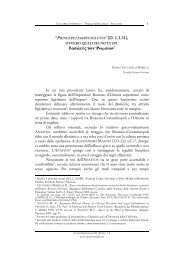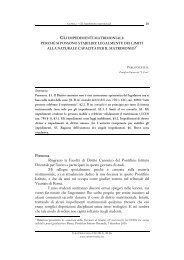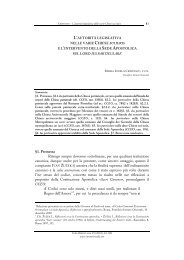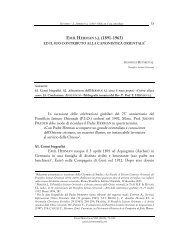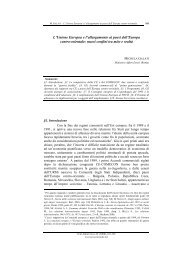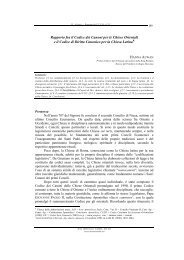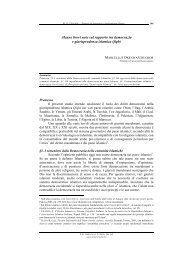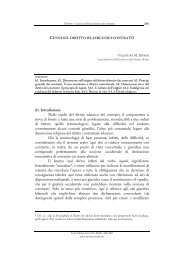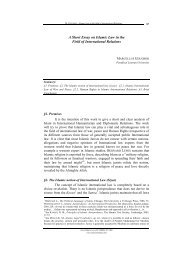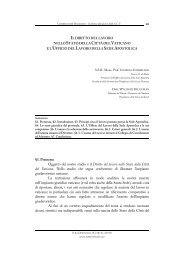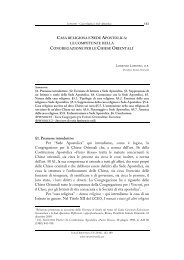The Canons of the Church and their ecclesiastical ... - iura orientalia
The Canons of the Church and their ecclesiastical ... - iura orientalia
The Canons of the Church and their ecclesiastical ... - iura orientalia
Create successful ePaper yourself
Turn your PDF publications into a flip-book with our unique Google optimized e-Paper software.
C. RUS – <strong>Canons</strong> <strong>and</strong> <strong>the</strong>ir Function: Some Remarks66Throughout <strong>the</strong> changing forms <strong>of</strong> <strong>the</strong> <strong>Church</strong>’s life, this awareness <strong>of</strong> <strong>the</strong>truth expressed in <strong>the</strong> canons thus remains «unalterable, unchangeable, valideverywhere <strong>and</strong> always for all those who confess <strong>the</strong> same doctrines <strong>of</strong> <strong>the</strong> faith. Thisquality contains <strong>the</strong> sure criterion for confronting <strong>and</strong> solving <strong>the</strong> various canonicalquestions that arise, as well as for appreciating <strong>the</strong> canonical forms in <strong>the</strong>ir totality» 16 .Viewed from this point <strong>of</strong> view, <strong>the</strong> position <strong>of</strong> <strong>the</strong> extreme conservatives isseen to be equally erroneous. <strong>The</strong>y start from <strong>the</strong> secure <strong>the</strong>ological conception that <strong>the</strong>Holy <strong>Canons</strong>, at least those <strong>of</strong> <strong>the</strong> Ecumenical Councils, are «nothing o<strong>the</strong>r than divinelaw itself, <strong>the</strong> seeds <strong>of</strong> which are contained in <strong>the</strong> Holy Scriptures, but which has beendeveloped <strong>and</strong> elucidated» 17 . <strong>The</strong>y extend <strong>the</strong> unchangeable as far as <strong>the</strong> verylegislative power <strong>of</strong> <strong>the</strong> <strong>Church</strong>, forgetting that it was <strong>the</strong> <strong>Church</strong> which instituted <strong>and</strong>ratified <strong>the</strong> Holy <strong>Canons</strong> <strong>and</strong> by accepting <strong>the</strong>m invested <strong>the</strong>m with authority.It cannot consequently be denied that it is <strong>the</strong> <strong>Church</strong> which possesses <strong>and</strong>always will possess <strong>the</strong> right to change in a legitimate fashion anything in its earliercanons which it finds needing to be changed or corrected. This right is inseparablyconnected with <strong>the</strong> essence <strong>of</strong> <strong>the</strong> <strong>Church</strong>’s legislative power. If we accept that <strong>the</strong>authority <strong>of</strong> <strong>the</strong> canons is higher than <strong>the</strong> <strong>Church</strong> itself which instituted <strong>the</strong>m, thismeans that not only do we see <strong>the</strong> <strong>Church</strong> as lower than its creation, <strong>and</strong> make itpermanently subject to that creation, but also that we put upon it <strong>the</strong> heavy burden <strong>of</strong>resurrecting many conditions <strong>of</strong> life <strong>and</strong> needs which have disappeared so as to effect<strong>the</strong> application <strong>of</strong> certain ancient regulations 18 .<strong>The</strong> function <strong>of</strong> <strong>the</strong> canons <strong>and</strong> <strong>of</strong> <strong>ecclesiastical</strong> law in general is intended (as acreative <strong>and</strong> protective element) to help <strong>the</strong> <strong>Church</strong>’s life to approach as far as possible<strong>the</strong> dogmatic teaching on <strong>the</strong> mystery <strong>of</strong> <strong>the</strong> <strong>Church</strong>. This, like all dogmas, is not<strong>the</strong>oretical or abstract truth, but is reflected in a whole series <strong>of</strong> expressions <strong>and</strong> isrealized in <strong>the</strong> life <strong>of</strong> <strong>the</strong> <strong>Church</strong>.This realization consists <strong>of</strong> <strong>the</strong> canonical organization, but this can never becomplete. No <strong>ecclesiastical</strong> form can be seen to exhaust <strong>the</strong> mystery <strong>of</strong> <strong>the</strong> <strong>Church</strong>, butonly to come near it, <strong>and</strong> this approach is relative to <strong>the</strong> historical moment at which itoccurs. For this reason, any absolutist form <strong>of</strong> <strong>Church</strong> organization is quiteunacceptable, because it confuses <strong>the</strong> empirical, relative <strong>and</strong> particular expression <strong>of</strong><strong>the</strong> <strong>Church</strong> with its unchangeable essence. <strong>The</strong> various historical forms are connectedto one ano<strong>the</strong>r absolutely by <strong>the</strong> dogmatic teaching underlying <strong>the</strong>m. Any modificationor change should <strong>the</strong>refore appear not only as a readjustment to historical conditions,but equally as a desire for fuller expression <strong>of</strong> <strong>the</strong> <strong>ecclesiastical</strong> mystery under newconditions <strong>and</strong> presuppositions. No change is legitimate except when <strong>the</strong> new structure<strong>of</strong> <strong>the</strong> <strong>Church</strong> expresses more clearly <strong>and</strong> extensively than <strong>the</strong> old <strong>the</strong> eternal dogmatictruth <strong>of</strong> <strong>the</strong> <strong>Church</strong>. We are free to modify, or even to create new forms, but we are notalways entitled to do this. In this question, as in <strong>the</strong> whole life <strong>of</strong> <strong>the</strong> <strong>Church</strong>, great16 AFANASSIEFF N., op. cit., 121.17 Cf. ARCHONTONES, op. cit., 27.18 CHRISTODOULOS A., op. cit., 61.IURA ORIENTALIA II (2006), 61-71www.<strong>iura</strong>orienalia.net


